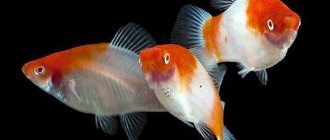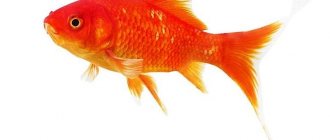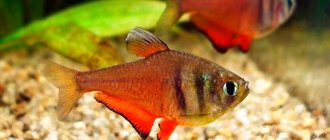The dwarf striped botia (Micronemacheilus cruciatus) RENDAHL was first described in 1944.
Representatives of the order Cypriniformes, Family of Ray-finned fish (Nemacheilidae)
Names synonyms
Russian: Yunnanilus cruciatus, Vietnamese multistriped char, Zebra botia, Dwarf cruciatus Latin: Yunnanilus cruciatus, Micronemacheilus cruciatus, Nemacheilus cruciatus Rendahl
Etymology
Micronemacheilus: from the Greek μικρός (mikrós) meaning small, νήμα (nēma) meaning "thread, filament" and χείλος (cheilos) meaning "lip" due to the fact that the genus is striated lip.
Yunnanilus: From Yunnan, a city in southwest China.
cruciatus: From the Latin crux, meaning "cross" in reference to the species' color pattern, which includes a dark lateral stripe with numerous vertical transverse stripes.
Habitat
Inhabits Central Vietnam.
Prefers shallow reservoirs, slow-flowing river areas, creeks, ponds and lakes. Such reservoirs have a soft sandy bottom and dense thickets of various plants.
Description
The elongated body is golden in color, with transverse black-chocolate stripes along the entire surface. Their number ranges from 14-18. If the fish is stressed, the stripes may become discolored. A longitudinal stripe is faintly visible, running from the eyes to the tail, at the base of which there is a black spot.
The fins are transparent with very thin black stripes. The dorsal fin consists of 8 branched rays. In the center of the upper lip there are 2 large papillae.
Size:
The average size of those living in an aquarium is 3.5 cm.
Appearance
Aquarium bots are not as large as wild species. Depending on the species, in artificial conditions they grow from 3.5 to 22 cm.
Almost all representatives of the breed are characterized by:
- subocular spines;
- thin and small cycloid scales;
- 6-8 pairs of whisker receptors, lower mouth;
- oblong, strong body compressed at the sides;
- rounded dorsal profile and flat belly.
The colors of bots are characterized by dark stripes or patterns, however, there are also monochrome phenotypes. Sexual dimorphism is not expressed.
Botsia are characterized by a rounded dorsal profile and a flat belly
Behavior and Compatibility
Compatible with small and peace-loving fish species. Small cyprinids from genera such as Boraras, Microdevario, Trigonostigma, Tanichthys and Microrasbora, as well as smaller danios such as D. erythromicron or D. margaritatus, are perhaps the best options, and many small Characins are likely to work as well.
Peaceful loaches and catfish should also do well, but as always, do your research carefully to avoid problems in the future.
Be sure to keep a group of at least 8-10 individuals, the more the better. Keeping them in this quantity will not only make the fish less restless and skittish, but will also result in a more efficient, natural-looking appearance and behavior.
Unlike most loaches, they spend a lot of time in open space, often hovering in the water column, exploring all levels of the aquarium.
This is interesting
The dwarf botia was not available to aquarists until the end of the last century due to its breeding habits. When the fish went on sale, prices were very high.
Now commercial breeding has begun, and reticulated bocilia has become very accessible. Admirers of the species have discovered many interesting features of the life of an aquatic inhabitant.
Hierarchy
Often the dominant place in the pack is occupied by the female. She possesses all the qualities of an “alpha” - courage, aggression, which this role requires of her. Supposedly, she can influence the character of the entire group.
Communication
Young individuals become the “shadow” of mature fish. They swim side by side with older members of the pack, and repeat every movement they see.
Sometimes there can be up to 4 fry next to one adult. Scientists cannot yet explain the reason.
But there is a hypothesis that mimicry is a consequence of a gregarious lifestyle. This behavior probably helps them survive floods. Ichthyologists do not rule out that this phenomenon is part of the communication process.
Bocilia make quite loud noises when excited. One version says that the sound is produced by the friction of pharyngeal teeth or subocular spines.
Aquarium
Basic dimensions are 60 * 30 cm or equivalent, given that they are best kept in a flock.
It prefers shelter from dense vegetation, tangles of branches and snags. Avoids bright light; partial shade should be created in the aquarium with the help of floating plants.
They spend a lot of time exploring the bottom, so it is preferable to choose soft sandy soil so that the fish do not damage their delicate antennae.
Water parameters:
Temperature: 22 - 27° C pH: 6.0 - 7.5 Hardness: 2 - 12° dH
The water should be well saturated with oxygen, the filtration is weak without turbulence, although a slight current is allowed. Be sure to perform regular partial water changes to maintain water quality.
Fish can only be introduced into mature aquariums. Do not introduce this fish into a biologically immature tank, as it may be susceptible to fluctuations in water chemistry.
Spreading
Dwarf bocilia is native to Southeast Asia. It lives in western Thailand, on the border with Myanmar. The fish was found in rivers and streams flowing in tropical forests. Favorite places are coastal areas, with shelters made of driftwood. The bottom is covered with sand and rock substrate and fallen leaves.
The reticulated loachfish is critically endangered and is included in the Red List of the International Union for Conservation of Nature.
Nutrition
In nature they eat zooplankton; in an aquarium, given their very good appetite, they accept any food, as long as it is small enough.
From frozen and live, daphnia, tubifex, cyclops, artemia nauplii, etc. are suitable. Dry food includes small or crushed food, which ideally should contain spirulina or other plant components.
They mainly pick up food from the bottom, as well as from leaves, snags and stones. Despite their peaceful disposition and tiny size, they are able to push smaller neighbors away from the feeding trough.
Feeding
Although all members of the genus Ambastaia are primarily carnivorous in nature, and most of their diet consists of insect larvae and various crustaceans, they can also feed on plant matter, in particular soft-leaved aquatic plants. When kept in an aquarium, A. sidthimunki does not cause any trouble in feeding. Omnivore. The main condition in nutrition is that the food should be small enough for this small fish. It is very important that the diet be varied, the fish will willingly eat live and frozen bloodworms, tubifex, artimia, good quality dry food, you can also offer the bots fresh fruits and vegetables, such as cucumber, melon, spinach or peeled zucchini. They can destroy small snails, but you should not purchase these bots expecting that they will be able to reduce the snail population in your aquarium. It is quite possible that your fish will not be interested in them.
Breeding
Like most small cyprinids, they freely scatter eggs and leave them unattended.
When the adult fish are in good condition and in a healthy tank they will spawn frequently, it is possible that a small number of fry can spawn without intervention but if you want to maximize the spawn a more controlled approach will be required.
A 10-15 liter spawning aquarium is filled with settled water, the temperature is set to 25-26°C. It is extremely undesirable to change other water parameters; the fish begin to experience prolonged stress. To reduce it, the aquarium is darkened on three sides. Fill most of the spawning tank with small-leaved plants, Java moss will also work. A washcloth made of artificial fibers can also bring good results. A weak flow generated by the filter and light aeration will not be amiss.
The fish are placed in the spawning tank in pairs or in a group of 4 females and 2 males. Nothing may happen for a whole week; the fish will behave awkwardly, refusing to eat. At this time, the water is changed by 5-10% every other day. Gradually they become accustomed and can begin to spawn. The readiness of the fish to spawn is manifested in the nervousness and fussiness of the male, who, swimming after the female, constantly pushes her in the abdomen with his head. The female lays several very small eggs. After spawning, the spawners move away.
The eggs are incubated for about three days. Until two weeks of age, fry are almost impossible to detect in the spawning area. They stay near the bottom all the time, hiding among stones and plants. As they grow older, they begin to swim around the aquarium more and more often and constantly feed.
The starting food for the first few days is ciliates; as the fry grow, switch to Artemia nauplii, microworms (nematodes) and other microfoods.
They grow unevenly, at the age of 2 weeks they grow to 10-15 mm. The stripes characteristic of adults appear by the age of three weeks, and at one month the fry already become a mini-copy of adult fish, both in behavior and appearance.
Life expectancy in an aquarium is 3-5 years.
Reviews about battles
Natalya Kononenko, review of dwarf botia
Very cheerful, energetic, playful. They are somewhat reminiscent of smart little monkeys. Not aggressive towards other fish. Very attractive in color and not demanding on living conditions. Clean the aquarium from algae fouling.
I really liked the fish. I took a pair. They are very interesting to watch. They love to poke their faces at each other and frolic. In the evening, both comrades, having played enough and been naughty, sink to the ground, as if they had been turned off, and begin to fall asleep funny, slightly falling on their sides, even if the light is on.
Kuzya Lytkarin, review of the striped botia
Wonderful fish! Even the cichlid’s evil neighbor will not allow himself to be offended; he manages to brush it off)) and how he eats, you have to hear it) crunches as if he’s gnawing on cucumbers) The fish has no scales, so it can easily catch some kind of infection. It is better to start a flock of 6 or more.
little, review of Clown Botia (macracantha)
beautiful fish! Cheerful, joyful, very interesting to watch. and their character is just like that of people. only one of mine was thin, inactive, and eventually died. By the way, if you see someone lying supposedly dead, wait. If he doesn’t wake up after 2 hours, then the worst has happened. I woke up and was just kidding.
I had BILLIONS, UNCOUNTED HORDES of snails, and some strange ones, with clowns it was like a cow licked it with its tongue! :)))))))))))))))))))))
All battles
Notes
Rendal (1944) described Nemacheilus cruciatus and established the genus Micronemacheilus for it. There it remained until 2001, when Freihof and Serov moved it to the genus Yunnanilus, based on the fact that it shares most of the diagnostic characters for the genus given by Kottelat (1988).
This placement resulted in the species being the only one of 30 species in the genus to have vertical stripes, 8 branched dorsal fin rays, and a pair of large papillae in the middle of the upper lip.
Kottelat (2012) considers the genus Micronemacheilus to be valid, but the only representative is M. cruciatus. No additional information is provided.
Diseases
In general, adult botia has good stable immunity. Infection with ichthyophthyriasis (semolina) and other fungal infections is possible. It is treated with the usual methods: increasing the water temperature, turning off the lights, adding special antifungal drugs. However, often, even if the entire aquarium is sick, the bots may remain unaffected by the infection. When treating an aquarium for infection, you should not remove healthy fish, so they can undergo preventive procedures.
Oxygen starvation
Pets lose their appetite and constantly rise to the surface of the water, gasping for air. The reason is overpopulation of the aquarium, lack of vegetation and lack of aeration. Treatment consists of eliminating provoking factors.
Chemical intoxication
Occurring due to the presence of chlorine or ammonia in water. The main symptoms are mucus on the gills, difficulty breathing, color change. Relocating your pets to a tank with clean water will help save them.
Stomach diseases
The main reason is poor quality food. Signs are the appearance of dark spots on the body, gradually turning into ulcers, enlargement of the abdomen, despite the lack of appetite, and the development of bulging eyes. The sick individual is removed and treated with streptocide or potassium permanganate.
To prevent infectious diseases, it is necessary to quarantine each new fish for a week before moving it into a community aquarium.











